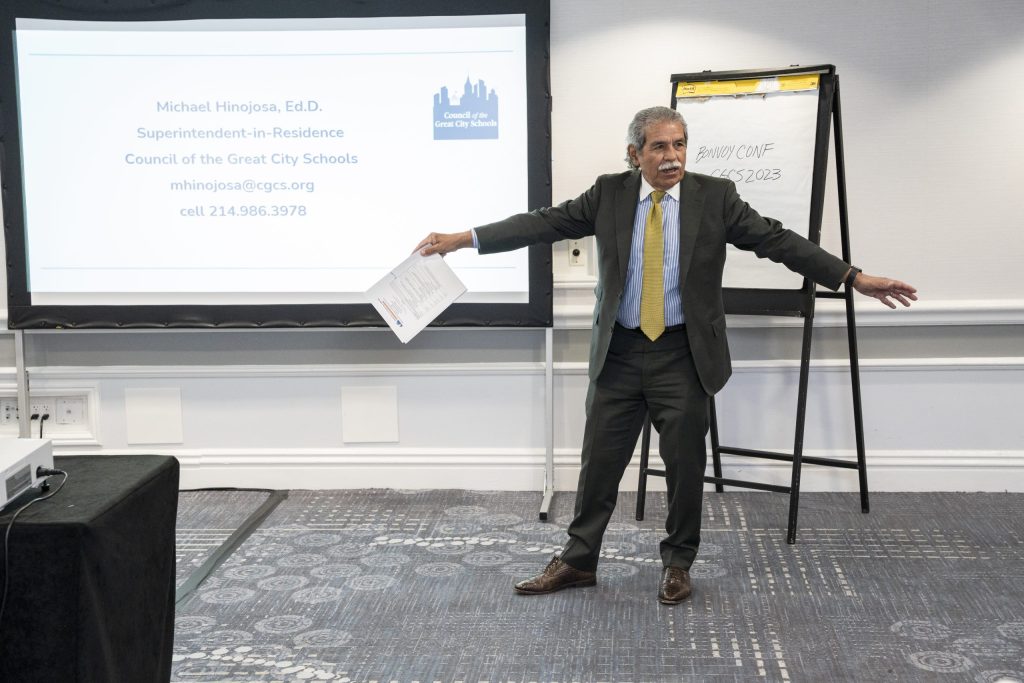Since 2020, most of the nation’s 78 urban school districts have had a new superintendent take over. Just 11 have been in their jobs for four years or more.
That statistic startled Michael Hinojosa. Hinojosa, who served for 13 years across two stints as the Dallas Independent School District, recently became superintendent-in-residence at the Council for the Great City Schools, a coalition representing those districts.
The pandemic made superintendents’ jobs even harder. On top of their other duties, they had to make decisions about masking and vaccines and address such issues as community food needs. The flare-up of the education culture wars in 2021 also added to the pressures on districts’ top administrators. Some superintendents transitioned to other roles in their communities or districts, while others chose to retire, according to Ray Hart, the council’s executive director.
Two years ago, the council asked Hinojosa to create an initiative to develop people for district leadership positions. Known as the Michael Casserly Urban Executive Leadership Institute, the year-long program prepares urban school district leaders to take on the superintendent role by providing training on the biggest challenges and responsibilities of the job post-pandemic, including politics and student behavioral and mental health challenges. The institute accepts 10 candidates a year who attend seven in-person, weekend-long sessions in addition to virtual meetings.
“It’s a very complex job,” said Hinojosa, “and we want to make sure you have a fighting chance for success.”
To design the curriculum, Hinojosa and his colleagues studied the qualities of successful superintendents. Those who could create connections with board, staff and community members had a much better chance of thriving in their jobs, he said. Based on that research, the sessions focus on topics such as school board relationships, finance and budgets, and media and politics. Instructors walk candidates through real case studies of school districts, diagnosing problems and coming up with potential solutions.
Matias Segura was appointed interim superintendent of the Austin Independent School District in December 2022, after five years as the district’s chief of operations. Around the same time, he got a call from Hinojosa encouraging him to apply for the program.
Cindy Marten, deputy secretary of education, speaks to a group of district leaders at the Michael Casserly Urban Executive Leadership Institute. Credit: Alex Jones/Council for the Great City Schools
Segura said the program has given him practical training, as well as access to a network of other leaders who are facing similar challenges.
“What really, really helped,” he said, “was how to be more effective once you’re in the seat.” In January, Segura was selected to remain as Austin’s permanent superintendent.
Hinojosa said the program is trying to select candidates from underrepresented demographic groups. Nationwide, only 4.4 percent of superintendents are Black and 3.1 percent are Hispanic, according to a 2023 survey by the School Superintendents Association. During the 2022-23 school year, women made up 28 percent of superintendents.
In addition to Segura, the first cohort included Ebony Johnson, who has since become Tulsa Public Schools superintendent, and Brenda Larsen-Mitchell, now interim superintendent for Clark County School District, in Nevada.
Both have taken over districts whose challenges reflect the times: Johnson, the Tulsa district’s former chief academic officer, became superintendent after former Superintendent Deborah Gist resigned in order to avoid a state takeover of the school system. Larsen-Mitchell, former deputy superintendent, was promoted after her predecessor took a buyout, following years of a tense relationship between the school board and educators.
Segura said a school leader preparation program is particularly vital for urban districts, many of which serve Black, Hispanic and emergent bilingual students.
“If you have individuals who aren’t ready to take the role, then our students are going to be impacted, which is why this type of cohort is so critically important,” Segura said. “A disruption can be catastrophic.”
This story about superintendents was produced by The Hechinger Report, a nonprofit, independent news organization focused on inequality and innovation in education. Sign up for the Hechinger newsletter.
The post New superintendents need ‘a fighting chance for success’ appeared first on The Hechinger Report.
Since 2020, most of the nation’s 78 urban school districts have had a new superintendent take over. Just 11 have been in their jobs for four years or more. That statistic startled Michael Hinojosa. Hinojosa, who served for 13 years across two stints as the Dallas Independent School District, recently became superintendent-in-residence at the Council for
The post New superintendents need ‘a fighting chance for success’ appeared first on The Hechinger Report. Future of Learning, News The Hechinger Report







